Jacques-Louis David Biography
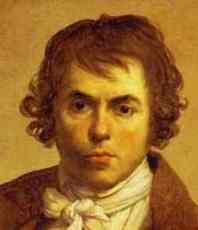
David was born into the family of a wealthy Parisian merchant on August 30, 1748. When the boy was about 10 years old his father, Louis-Maurice, died after a pistol duel. David's two uncles, François Buron (1731-1818) and Jacques- François Desmaisons (c.1720-89) who were both architects and building contractors, took care of the boy's upbringing. First he was educated at a boarding school and the Collège des Quatre Nations in Paris. When he decided on the career of an artist his uncles helped him to become a student of Joseph-Marie Vien (1716-1809), a professor at the Academy who had a reputation as a good teacher. As many young painters, David used his close relatives as his models, thus he painted both his uncles, his aunt Marie-Josephe, and his cousin Marie-Françoise, who had supported his wish to become a painter.
In 1766-1774 David studied at the Royal Academy of Painting and Sculpture, in Vein's class. The goal of practically every Academy student was to win the premier student prize: the Grand Prix, or Prix de Rome. David took part in the competition every year starting from 1770, until at last in 1774 he finally won it with Antiochus and Stratonice. After that he spent 5 years in Italy (1775-1780), where drew from antique models. On his return to Paris in 1780, Ancient history and mythology became his favorite subject. In 1781 David was made an Associate member of the Academy for his work Belisarius, which was much admired, and two years later, in 1783, he became a full Academician for Andromache Mourning Hector. In 1784, he fulfilled Louis XVI’s commission - The Oath of the Horatii.
David enthusiastically greeted the French Revolution and from 1789 he actively participated in political life. In 1791 he was elected a deputy of the Convention from Paris. He voted for the death of Louis XVI in 1793 and supported Robespierre’s and the left radicals’ regime; David was a member of the Committee of Public Safety and artistic director of the great national fêtes founded on classical customs. After the 9 Termidor (27 July) 1794 coup, when Robespierre and his closest supporters were overthrown and hurriedly executed by the temporary coalition of both left- and right-wing moderates in the Convention, David was arrested twice and narrowly escaped with his life. His political career ended, but his artistic career revived. The most prominent work of the second half of the 1790s was The Intervention of the Sabine Women.
In 1797 he met Napoleon and was granted a single portrait sitting, during which David did not manage to paint much, but was absolutely captivated by Napoleon's personality. Later on David created many paintings devoted to his new hero and his relatives: Bonaparte Crossing the St. Bernard Pass (1800), Napoleon in His Study (1812), the grandiose canvases Consecration of the Emperor Napoleon I and Coronation of the Empress Josephine (1808), The Distribution of the Eagle Standards, etc.
In 1802 Napoleon founded the Legion of Honor, and David was made a Knight (or Chevalier) of the Legion (the first of the five ranks of the order) in December 1803. During the following years he would reach the third rank of the order, a Commander (or Commandant) of the Legion of Honor (1815).
After the fall of Napoleon and the Bourbon restoration David was banished in 1816 as a regicide, and fled to Brussels, where he spent his last 10 years. During this period he returned to mythological subjects and intimate portraiture. David died on 29 December 1825 and was buried at the Saint-Josse-ten-Noode cemetery, Brussels.
The influence of David was very high. He was an outstanding teacher; from his studio came Gros, Gérard, Ingres, and many others. The art of their teacher and their own influenced the European art until Impressionism.
Bibliography
Jacques-Louis David. by I. Kuznetsova. Moscow. 1965.
David. by Simon Lee. Phaidon. 1999.
Painting of Europe. XIII-XX centuries. Encyclopedic Dictionary. Moscow. Iskusstvo. 1999.
Neoclassicism (Art & Ideas) by David G. Irwin. Phaidon Press Inc., 1997.
Jacques-Louis David, Revolutionary Artist: Art, Politics, and the French Revolution by Warren Roberts. Univ of North Carolina Pr, 1992.
Jacques-Louis David by Dorothy Johnson. Princeton Univ Pr, 1993.
Jacques-Louis David: Empire to Exile by Philippe Bordes. Clark Art Institute, 2005.
Jacques-Louis David's'Marat' by Will Vaughn, Helen Weston. Cambridge University Press, 1999.
Portraiture in Paris Around 1800: Cooper Penrose by Jacques-Louis David by Philippe Bordes. Timken Museum of Art, 2004.
- Antiochus And Stratonice.
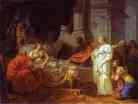
1774. Oil on canvas. 120 x 155 cm. École Nationale Supériere des Beaux-Arts, Paris, France. Read Note.
- Belisaire Demandant L'Aumone.
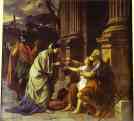
1781. Oil on canvas. 288 x 312 cm. Musée des Beaux-Arts, Lille, France.
- Andromache Mourning Hector.
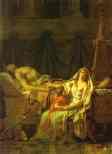
1783. Oil on canvas. The Pushkin Museum of Fine Art, Moscow, Russia. Read Note.
- The Oath Of Horatii.
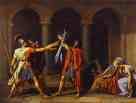
1784. Oil on canvas. 330 x 425 cm. Louvre, Paris, France. Read Note.